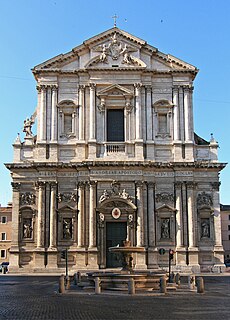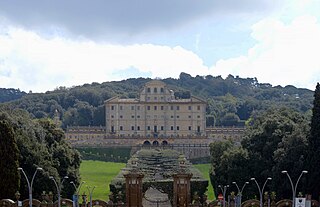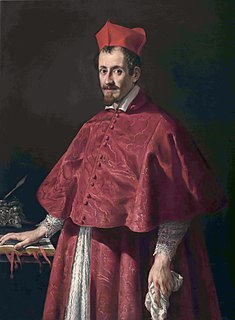

Orazio Falconieri (died 1664) was an Italian nobleman from Florence; he was the owner of the Villa Falconieri. His heraldic symbol was a falcon [1]


Orazio Falconieri (died 1664) was an Italian nobleman from Florence; he was the owner of the Villa Falconieri. His heraldic symbol was a falcon [1]
Falconieri was the son of Paolo Falconieri and Maddalena Albizzi and the brother of Lelio Falconieri [2] who was later elevated to Cardinal.
In 1615 he married Ottavia Sacchetti (1590–1645), sister of Cardinal Giulio Cesare Sacchetti [3] who would later consecrate Orazio's brother Lelio. The Sacchetti and Falconieri were already close; Orazio's father had made his fortune importing salt and as a result Orazio had business connections to Ottavia Sacchetti's father. When Ottavia's first husband, Piero Alberti, died, marriage to Orazio was considered an excellent option for both families. [4] Records indicate they had at least one son (Paolo Francesco Falconieri) who took ownership of the Villa Falconieri and took his father's titles. [5]
Falconieri purchased the Villa Falconieri and commissioned Francesco Borromini to renovate it. Orazio later commissioned Borromini to renovate the church of San Giovanni dei Fiorentini to build a Falconieri family chapel for his burial and the burial of his brother Lelio Falconieri. [6]

Francesco Borromini, byname of Francesco Castelli, was an Italian architect born in the modern Swiss canton of Ticino who, with his contemporaries Gian Lorenzo Bernini and Pietro da Cortona, was a leading figure in the emergence of Roman Baroque architecture.

The Orsini family is an Italian noble family that was one of the most influential princely families in medieval Italy and Renaissance Rome. Members of the Orsini family include three popes: Celestine III (1191–1198), Nicholas III (1277–1280), and Benedict XIII (1724–1730). In addition, the family included 34 cardinals, numerous condottieri, and other significant political and religious figures.

Pietro da Cortona was an Italian Baroque painter and architect. Along with his contemporaries and rivals Gian Lorenzo Bernini and Francesco Borromini, he was one of the key figures in the emergence of Roman Baroque architecture. He was also an important designer of interior decorations.

Sant'Andrea della Valle is a minor basilica in the rione of Sant'Eustachio of the city of Rome, Italy. The basilica is the general seat for the religious order of the Theatines. It is located at Piazza Vidoni, 6 at the intersection of Corso Vittorio Emanuele and Corso Rinascimento.

The Palazzo Spada is a palace located on Piazza di Capo Ferro #13 in the rione Regola of Rome, Italy. Standing very close to the Palazzo Farnese, it has a garden facing towards the Tiber river.

The Villa Falconieri is a villa in Frascati, Italy.

Daniele Matteo Alvise Barbaro was an Italian architect, writer on architecture, and translator of, and commentator on, Vitruvius. He also had a significant ecclesiastical career.

The Villa Aldobrandini is a villa in Frascati, Italy. Still the property of, and still lived in by, the Aldobrandini family, it is known as Belvedere for its charming location overlooking the valley toward the city of Rome.

Pier Francesco Orsini, also called Vicino Orsini, was an Italian condottiero, patron of the arts and duke of Bomarzo. He is famous as the commissioner of the Mannerist Park of the Monsters in Bomarzo.

San Giovanni dei Fiorentini is a minor basilica and a titular church in the Ponte rione of Rome, Italy.

Antonio Barberini was an Italian Catholic cardinal, Archbishop of Reims, military leader, patron of the arts and a prominent member of the House of Barberini. As one of the cardinal-nephews of Pope Urban VIII and a supporter of France, he played a significant role at a number of the papal conclaves of the 17th century. With his brothers Cardinal Francesco Barberini and Taddeo Barberini he helped to shape politics, religion, art and music of 17th century Italy. He is sometimes referred to as Antonio the Younger or Antonio Barberini iuniore to distinguish him from his uncle Antonio Marcello Barberini.
Giovanni Magenta (1565–1635) was an Italian architect. He designed the cathedral of San Pietro at Bologna (1605). It was later modified by Alfonso Torreggiani (1765). He designed the church of San Salvatore in Bologna (1605–1623) and San Paolo.

The Palazzo Falconieri is a palace in Rome, Italy formed in the seventeenth century as a result of remodelling by the Baroque architect Francesco Borromini. It is the home of the Hungarian Academy Rome, since its foundation in 1927. It is located between Via Giulia and Lungotevere, with entrances to both; it is near Palazzo Farnese and a few houses down and across Via Giulia from the church of Santa Caterina della Rota in the Rione of Regola. From 1814, it was occupied by cardinal Joseph Fesch, Napoleon's uncle.

Giulio Cesare Sacchetti was an Italian Catholic Cardinal and was twice included in the French Court's list of acceptable candidates for the Papacy, in 1644 and 1655.

Lelio Falconieri (1585–1648) was an Italian Catholic Cardinal.

The House of Sacchetti is an Italian noble family originating in Tuscany, now resident in Rome, whose earliest documented member Merlo lived during the late 10th and early 11th centuries. The name of the family is derived from one or more members known as Sacchetto. According to Ugolino di Vieri (1438–1516),"nobile Sacchetti genus est, moenia primus romanus sangius".
Falconieri is a surname, and may refer to:

The Galleria Spada is a museum in Rome (Italy), which is housed in the Palazzo Spada of the same name, located in the Piazza Capo di Ferro. The palazzo is also famous for its façade and for the forced perspective gallery by Francesco Borromini.

Palazzo Giustiniani or the Piccolo Colle is a palace on the Via della Dogana Vecchia and Piazza della Rotonda, in Sant'Eustachio, Rome.

The Altoviti are a prominent noble family of Florence.